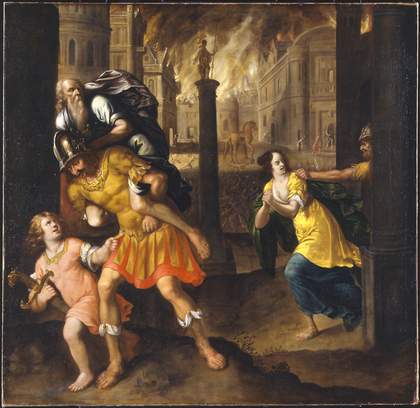
Fig.1
Henry Gibbs 1631–1713
Aeneas and his Family Fleeing Burning Troy 1654
Tate
T06782
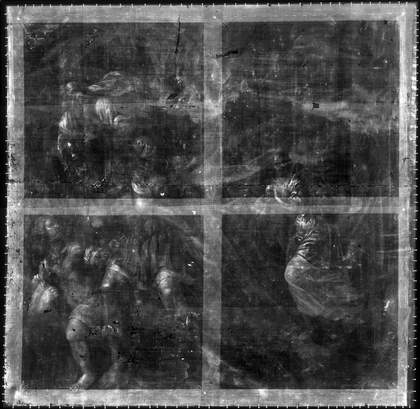
Fig.2
X-radiograph of Aeneas and his Family Fleeing Burning Troy
The painting is in oil paint on canvas measuring 1550 x 1598 mm (fig.1). The support consists of two pieces of plain woven linen joined by a horizontal seam running just above the centre (fig.2). The top piece measures between 703 mm at the right upright edge, 677 mm at the left and 1594 mm across the width; the bottom piece measures between 845 mm at the right edge and 859 mm at the left, and is 1598mm wide. Both canvases have an average weave count of 13 horizontal and 13 vertical threads per square centimetre. The fabric is coarse, with threads of uneven thicknesses, and slubs. The painting is now lined with glue paste adhesive, and the reverse was further impregnated with beeswax. The stretcher is not original and dates from the time of lining.
There are old lines of cracks in the paint, relating to the inner edges of a former stretcher or strainer. These run about 35 mm in from the top edge, approximately 47 mm in from the bottom edge and 48 mm in from the right edge. No such cracks were apparent at the left, although prominent cusping runs along this side of the canvas, which indicates that this side has not been trimmed, whereas the other sides have been.1 There are also cracks created by two corner braces at the top and bottom right. Cusping of the canvas was found along both left and right edges but was less pronounced along the bottom and not evident along the top edge.
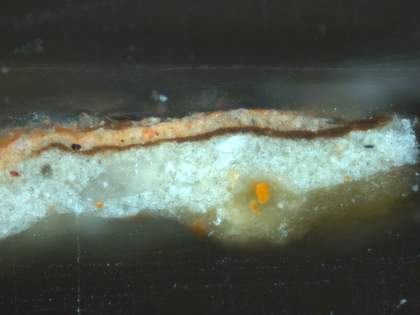
Fig.3
Cross section taken from the mid tone of Aeneas’ right foot, 425mm from the left and 95mm from the bottom edge, photographed at x320 magnification. From the bottom upwards: sliver of ground (not the full thickness) with a large lead soap aggregate mineralised to red lead; grey priming; brown first painting of the figure; flesh tone; varnish
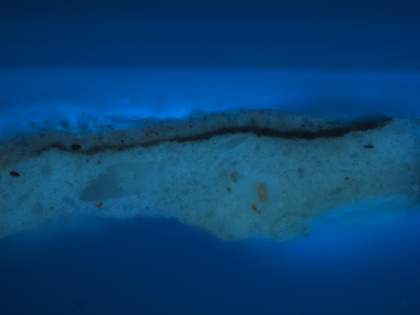
Fig.4
The same cross-section as in fig.3, photographed at x320 magnification in ultraviolet light
The ground appears to be bound in oil, and is warm, off-white in colour. It is rich in marine chalk, mixed with lead white, some fine black and a little brown earth colour.2 This layer was also found to contain red lead in spots; it is less likely that the red lead represents a deliberate admixture by the artist, and more probable that it has formed from the lead soaps aggregates that have developed (figs.3–4). The ground is covered with a pale grey priming consisting of the same pigment mixture as the ground but with a greater amount of lead white and fine black, less chalk and traces of red earth, vermilion, and lead-tin yellow This layer was also found to contain glassy particles. The priming is leanly bound and has been applied thinly with a smooth and even texture.
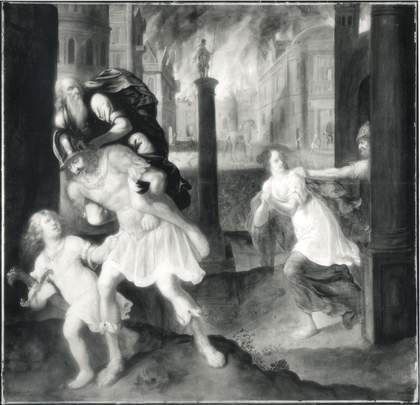
Fig.5
Infrared reflectogram of Aeneas and his Family Fleeing Burning Troy
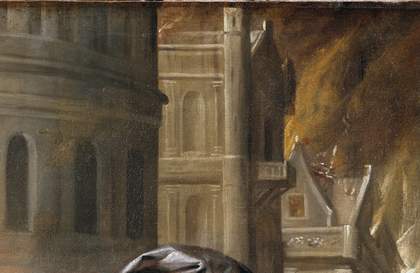
Fig.6
Detail of the architecture in Aeneas and his Family Fleeing Burning Troy
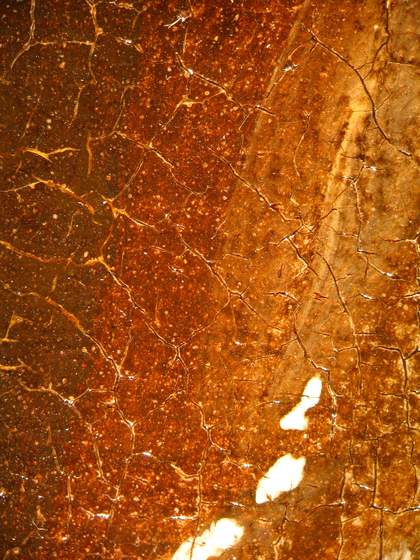
Fig.7
Photomicrograph at x8 magnification of the helmet in Aeneas and his Family Fleeing Burning Troy, showing warm brown first painting left visible as shadow
No distinct underdrawing was found using infrared reflectography (fig.5) but it seems that the artist used grey paint to outline the buildings in the background, as this can be seen with the unaided eye in a pentimento to the architecture above the figure group at the right (fig.6). Likewise, a broad painted laying-in can be seen in the alteration to the shape of the windows in the turret at the right. A wash of warm, brown oil paint was used to establish the foreground figures (fig.3 and fig.7).
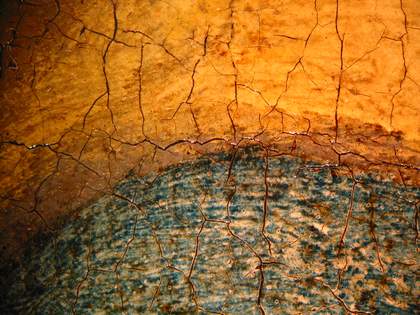
Fig.8
Photomicrograph at x8 magnification of the grey priming left visible at the junction of the yellow and blue draperies worn by the Aeneas’ wife Creusa

Fig.9
Cross-section taken from the blue drapery 265mm from the right and 334mm from the bottom, photographed at x320 magnification. From the bottom of the sample upwards: sliver of ground; grey priming; dark blue underpaint of drapery; white highlighted area of drapery; dark blue glaze; varnish
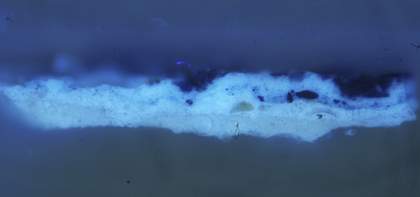
Fig.10
The same sample as in fig. 9, photographed at x320 magnification in ultraviolet light

Fig.11
Photomicrograph at x8 magnification of the woman’s cloak, showing yellow underpaint with a green glaze
Gibbs’ painting technique demonstrates both a certain level of planning and his strategic use of materials. The painting was laid in using a very direct method, leaving reserves not only for the figures but for separately coloured areas. For example, the grey priming can be seen along the junction of the yellow and blue draperies worn by the woman (fig.8). Gibbs painted the flesh sparingly, leaving the grey priming visible in the mid-tones and using a loose, almost sketchy handling to depict the faces of the foreground figures. Gibbs consistently worked from dark to light, both in the flesh paints and the draperies, but there is a more complicated structure in the build-up of the green and blue areas. Flesh colours and less saturated colours of the pink, purple and yellow draperies are worked mostly wet-in-wet with the later addition of highlights, whereas the green and blue draperies have a more distinct build-up. The blue drapery was laid down with a dark blue paint containing lead white and indigo. White paint was then applied over this to denote isolated highlights and the whole drapery was then glazed with blue containing azurite and indigo (figs.9–10). Likewise, the green drapery was modelled in an underpaint of fairly dark green made up of lead white, blue (probably indigo), yellow and green. Highlights, mostly in lead-tin yellow, were then added and the whole thing was finally glazed with transparent verdigris paint (fig.11). A red glaze on Aeneas’s tunic has faded with time.
Gibbs’s palette consisted of lead white, vermilion, lead-tin yellow, verdigris, red lake, azurite, indigo, black, yellow ochre, sienna, red and brown earths, chalk and ground glass. The good quality and strong colour of Gibbs’ earth palette is notable, particularly his use of sienna in the depiction of burning Troy. Chalk and ground glass are present in most of the colour mixtures as bulking agents and to assist the drying of the oil paint.
August 2020
